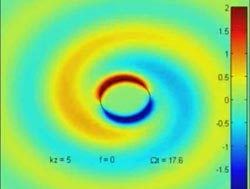How Earth's rotation affects vortices in nature

This is a view from above of the growing and spiraling wave field emitted by a geophysical vortex due to the radiative instability. The black circle represents a boundary of the vortex core.<br><br>Credit: J. Park/Ecole Polytechnique-CNRS<br>
What do smoke rings, tornadoes and the Great Red Spot of Jupiter have in common?
They are all examples of vortices, regions within a fluid (liquid, gas or plasma) where the flow spins around an imaginary straight or curved axis. Understanding how geophysical (natural world) vortices behave can be critical for tasks such as weather forecasting and environmental pollution monitoring.
In a new paper in the journal Physics of Fluids, researchers Junho Park and Paul Billant of the CNRS Laboratoire d'Hydrodynamique in France describe their study of one such geophysical vortex behavior, radiative instability, and how it is affected by two factors, density stratification and background rotation.
Radiative instability is a phenomenon that alters the behavior of fluid flows and can deform a vortex. The “radiative” tag refers to the fact that it is an instability caused by the radiation of waves outward from a vortex.
“These waves can exist as soon as there is a density stratification — a variation of densities — throughout the vertical column of the vortex,” Park said. “In this study, we have considered how background rotation — in this case, the rotation of the Earth — impacts them.”
Examples of density stratification in nature, Park explained, include the decrease in air density as one moves higher in the atmosphere or the increase in water density due to salinity and temperature with increasing ocean depth. “So, the waves in our mathematical model are somewhat analogous to waves on the ocean surface,” he said. “Likewise, the impact from background rotation on our modeled waves serves as an equal for the impact of the Coriolis force caused by the Earth's rotation.”
“What we learned from our models is that strong background rotation suppresses the radiative instability, a characteristic that had been expected but whose dynamics had never been studied precisely,” Park said. “We've now developed a sophisticated mathematical means to explain this phenomenon, and that's important to being better able to study and understand the behavior of geophysical vortices such as hurricanes and ocean currents.”
Park said that he and Billant next plan to study instability behaviors in vortices with non-columnar shapes. “For example,” he said, “there are pancake-shaped flows called Mediterranean eddies, or meddies, that would be worth studying since we know they affect the mixing of the components that make up the ocean ecosystem.”
The article, “Instabilities and waves on a columnar vortex in a strongly-stratified and rotating fluid” by Junho Park and Paul Billant appears in the journal Physics of Fluids. See: http://dx.doi.org/10.1063/1.4816512
ABOUT THE JOURNAL
Physics of Fluids is devoted to the publication of original theoretical, computational, and experimental contributions to the dynamics of gases, liquids, and complex or multiphase fluids. See: http://pof.aip.org
Media Contact
More Information:
http://www.aip.orgAll latest news from the category: Physics and Astronomy
This area deals with the fundamental laws and building blocks of nature and how they interact, the properties and the behavior of matter, and research into space and time and their structures.
innovations-report provides in-depth reports and articles on subjects such as astrophysics, laser technologies, nuclear, quantum, particle and solid-state physics, nanotechnologies, planetary research and findings (Mars, Venus) and developments related to the Hubble Telescope.
Newest articles

Silicon Carbide Innovation Alliance to drive industrial-scale semiconductor work
Known for its ability to withstand extreme environments and high voltages, silicon carbide (SiC) is a semiconducting material made up of silicon and carbon atoms arranged into crystals that is…

New SPECT/CT technique shows impressive biomarker identification
…offers increased access for prostate cancer patients. A novel SPECT/CT acquisition method can accurately detect radiopharmaceutical biodistribution in a convenient manner for prostate cancer patients, opening the door for more…

How 3D printers can give robots a soft touch
Soft skin coverings and touch sensors have emerged as a promising feature for robots that are both safer and more intuitive for human interaction, but they are expensive and difficult…





















